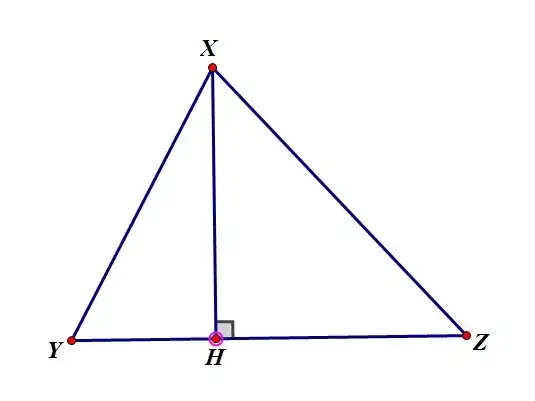The inaccuracy is, unfortunately, yours. The step $(a+b)^2=(2d)^2+c^2$ is not a proper way of handling the Pythagorean relations.
If the altitude (of length $d$) separates the base into parts $p$ and $q$, then Pythagoras lets us write
$$a^2 = d^2 + p^2 \qquad\text{and}\qquad b^2 = d^2 + q^2 \tag{1}$$
We can use the relation $p+q=c$ to combine these into an equation that allows us to solve for $d$.
Your error, I believe, was in attempting to combine the squared elements in $(1)$, term-by-term:
$$(a+b)^2 = (d+d)^2 + (p+q)^2 \qquad(\text{error!})$$
This would be a very convenient algebraic trick, if it worked; but it doesn't. For example,
$$5^2=3^2+4^2 \qquad 13^2=5^2+12^2 \qquad\text{but}\qquad \underbrace{(5+13)^2}_{324}\neq\underbrace{(3+5)^2+(4+12)^2}_{320}$$
Instead, we have to work quite a bit harder. We can start by replacing $q$ in $(1)$ with $c-p$:
$$\begin{align}
b^2 &= d^2 + (c-p)^2 \tag{2}\\
&= d^2 + c^2 + p^2 - 2 c p \tag{3}\\
&= d^2 + c^2+(a^2-d^2) - 2 c p \tag{4}\\
&=a^2 + c^2 - 2 cp \tag{5}\\
2 cp&= a^2 -b^2 + c^2 \tag{6}\\
4c^2p^2 &= ( a^2 -b^2 + c^2)^2 \tag{7}\\
4c^2(a^2-d^2) &= a^4 + b^2 + c^4 - 2 a^2 b^2+2a^2c^2-2b^2c^2 \tag{8}
\end{align}$$
For the problem at hand, we can substitute $a=13$, $b=15$, $c=14$ to get
$$4\cdot 196 \cdot( 169 - d^2 ) = 19600 \quad\to\quad 169 - d^2 = 25 \quad\to\quad d^2 = 144 \quad\to\quad d = \pm 12$$
where we discard the extraneous negative option. Thus, $d=12$, as expected. $\square$
I could stop here, but I won't. Bear with me as I continue manipulating $(8)$ ...
$$\begin{align}
4a^2c^2-4c^2d^2 &= a^4 + b^2 + c^4 - 2 a^2 b^2-2a^2c^2-2b^2c^2 \tag{9} \\[4pt]
-4c^2d^2 &= a^4 + b^2 + c^4 - 2 a^2 b^2-2a^2c^2-2b^2c^2 \tag{10}\\[4pt]
4c^2d^2 &= (a+b+c)(-a+b+c)(a-b+c)(a+b-c) \qquad(\text{trust me}) \tag{11}\\[4pt]
\frac14 c^2d^2 &= \frac{1}{16}(a+b+c)(-a+b+c)(a-b+c)(a+b-c) \tag{12}\\[4pt]
\left(\frac12 c d\right)^2 &= \frac{a+b+c}{2} \cdot \frac{-a+b+c}{2} \cdot \frac{a-b+c}{2}\cdot \frac{a+b-c}{2} \tag{13}
\end{align}$$
Interestingly, if we define $s = (a+b+c)/2$, we have
$$s-a = \frac12(a+b+c)-a = \frac12(a+b+c-2a)=\frac{-a+b+c}{2} \tag{14}$$
Also,
$$s- b = \frac{a-b+c}{2} \qquad s-c = \frac{a+b-c}{2} \tag{15}$$
Thus, $(13)$ becomes
$$\left(\frac12cd\right)^2 = s(s-a)(s-b)(s-c) \tag{16}$$
But $\frac12 cd$ is the area of the triangle! Therefore,
$$\text{area}= \sqrt{s(s-a)(s-b)(s-c)} \tag{$\star$}$$
We have re-proven Heron's formula! $\square$
